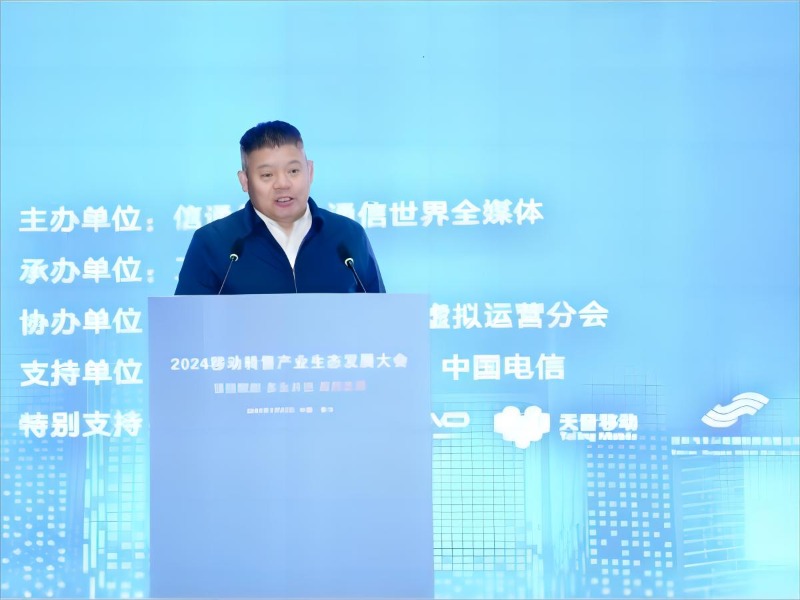The Key to Developing New Productive Forces Is to Promote Industrial Innovation through Scientific and Technological Innovation
(CWW) Since it was first proposed in September 2023, new productivity has become a hot word in the Chinese economy. At the National Two Sessions in 2024, new productivity was included in the government work report for the first time, and accelerating the development of new productivity was listed at the top of the top ten tasks in 2024. At a time when new productivity has become a hot word, how to speed up the development of new productivity has become a topic discussed by all walks of life.
On March 20, at the "2024 Mobile Resale Industry Ecological Development Conference" hosted by Xintong Media·Communication World All Media, hosted by the Internet of Industry, and co-organized by the Virtual Operation Branch of the China Communications Enterprises Association, Deputy Chief Engineer of the China Academy of Information and Communications Technology He Wei said that after reviewing the content of new productivity in existing reports and meetings, it can be found that to accelerate the development of new productivity, it is especially important to give full play to the leading role of innovation and promote industrial innovation with technological innovation.

Promoting industrial innovation through scientific and technological innovation is the core element of developing new productive forces. At the same time, industrial innovation will help accelerate the application and implementation of scientific and technological innovation achievements.
Talking about why technological innovation should be used to promote industrial innovation, He Wei explained that "innovation" is the entire chain from front-end basic research, applied basic research, to technology development, productization, and then to scale and industrialization. Technological innovation mainly focuses on the improvement of scientific and technological levels. Industrial innovation is the process of using scientific and technological innovation results to form new industries or transform existing industries. Its goal is to apply appropriate factor inputs, technical levels and organizational methods to obtain higher value output benefits. Therefore, accelerating the promotion of industrial innovation is particularly important for the development of new productive forces.
"Under the new situation, the need for industrial innovation is becoming more urgent." He Wei said, on the one hand, digitalization is integrating and penetrating into the industrial economy in an unprecedented way, and giving birth to digital economic forms, artificial intelligence, quantum information, humanoid robots, brain-computer Digital technologies such as interfaces will become the biggest variables of the times and technology. On the other hand, the global division of labor has driven the continuous adjustment of the competition pattern, factor structure and development direction of the value chain. Countries have seized the key hub position in the global innovation network. The new pattern of the global value chain will see the coexistence of multiple powers, multi-regional development, and diverse co-governance.
He Wei said that at present, our country is facing challenges in both short-term and long-term dimensions. In the short term, in the past, our country relied more on imitation and innovation to make up for the technological gap, but this window is closing. In the long run, all countries are actively seizing frontier fields including future industries. Whoever seizes the first-mover advantage will be able to occupy the commanding heights. It can be said that we are facing both "make-up lessons" in traditional fields and leadership in emerging fields. Future development requires us to be more diverse, so industrial innovation should be emphasized at this stage.
"With the development of the entire industry, we have seen that my country's industrial innovation has developed very rapidly in the past decade or so, achieved many achievements, and entered a new stage." He Wei introduced.
Specifically, my country's industrial innovation has entered a new stage, mainly reflected in three aspects.
First, my country has entered the ranks of global innovative countries. The "2022 Global Innovation Index Report" shows that China ranks 11th, rising steadily for 10 consecutive years, ranking first among 36 middle- and high-income economies, and ranking first in the world in 9 subdivision indicators.
Second, my country’s industrial innovation achievements have emerged one after another. The advantages of the entire industry chain in the fields of mobile communications, high-speed rail, and equipment continue to increase, and the competitive advantages of the industry chain such as new energy vehicles, photovoltaics, and ships are further strengthened, and industrial innovation models and experiences are explored in some key areas.
Third, the industrial innovation system is gradually improved. For a long time in the past, our country has been a latecomer country, and its industrial innovation has focused on catching up. An industrial innovation system that adapts to the characteristics of the catching-up stage has been initially constructed, laying the foundation for the construction of a modern industrial system. At present, industrial innovation has entered an era of "three races": following, running alongside, and leading. It is necessary to accelerate the construction of an ecosystem that supports multiple types of industrial innovation.
However, in the long run, my country's industrial innovation still faces difficulties such as the prominent gap in the intensity of innovation investment across society, the slow increase in the proportion of high-tech industries, and the lack of leading enterprises with a leading role.
He Wei believes that in the future, on the supply side, the industry still needs to strengthen the supply of common industrial technologies and improve the synergy between industry, academia and research; on the demand side, it needs to match innovation needs and accelerate scale; on the institutional side, it needs to promote the construction of "technology-industry-finance" A high-level circular industrial innovation ecosystem.